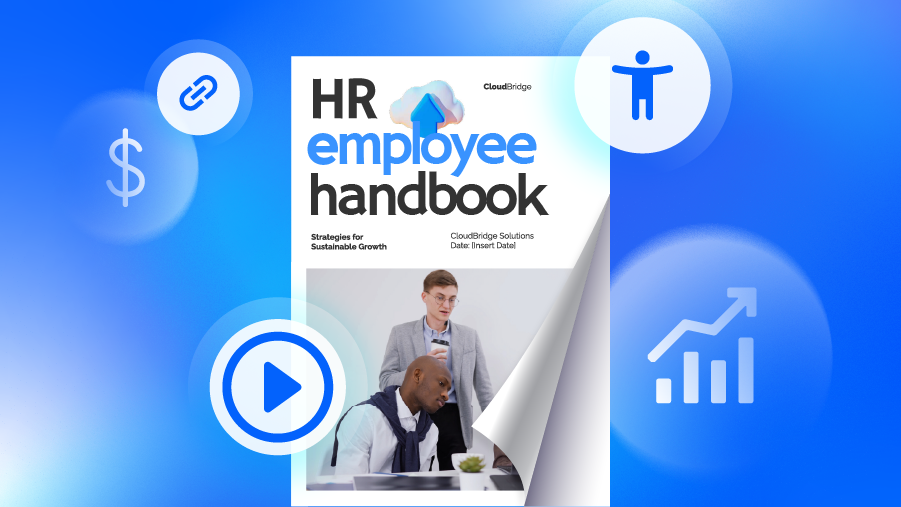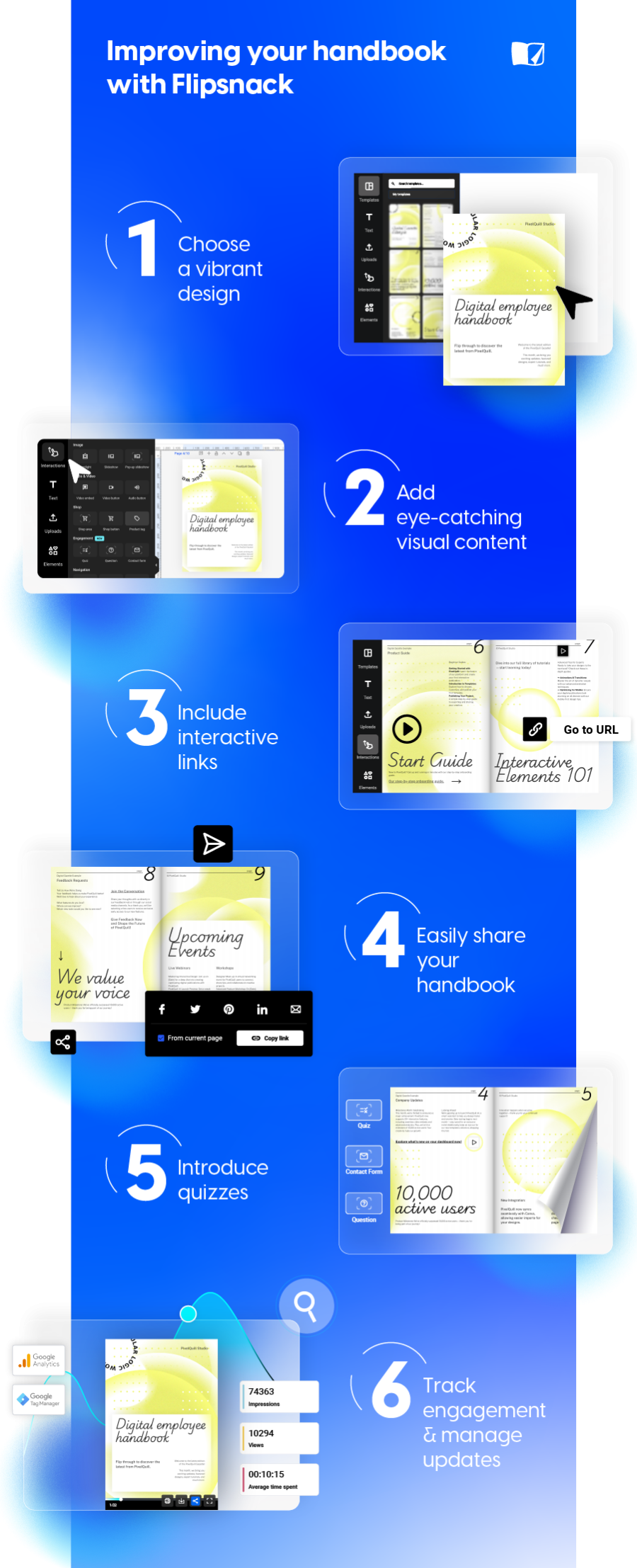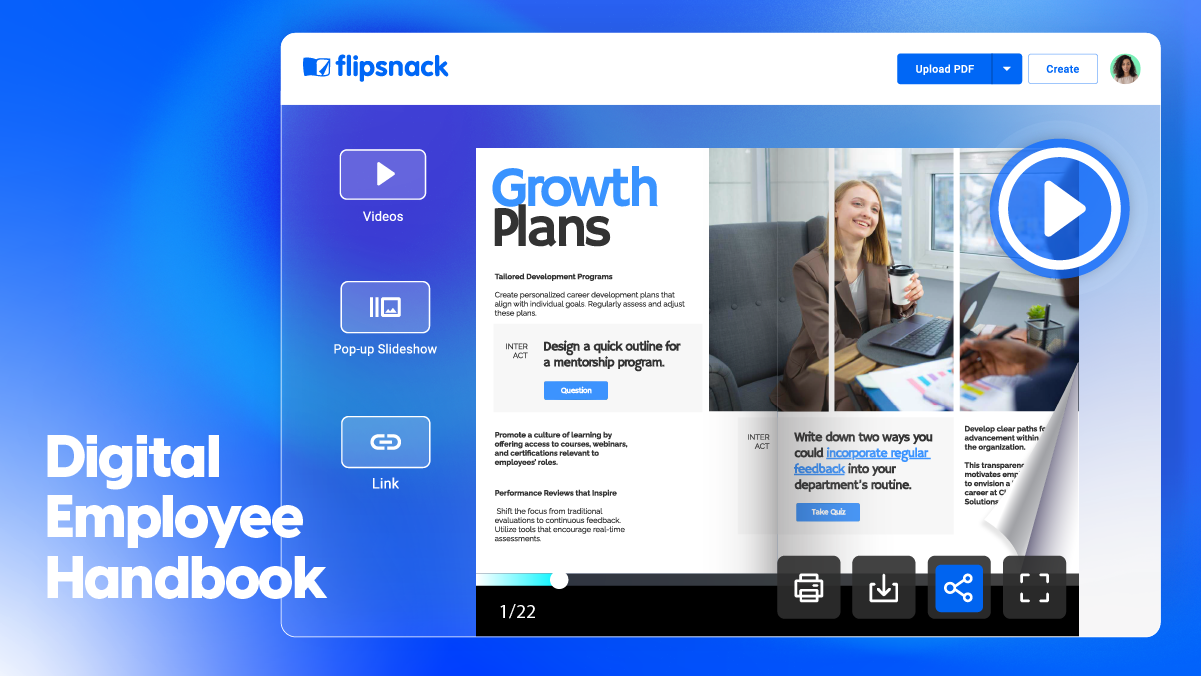How to create your employee handbook online: Streamlining your HR processes
Last updated: January 16th, 2025
Are you ready to create your digital employee handbook for your business but don’t know where to start? If so, you’ve made it to the right place!
By now, you know that every successful organization needs a roadmap for its employees to follow. Establishing a handbook that goes over necessary information about company policies, procedures, and expectations will ultimately lead to more engaged, aware employees. At the same time, you get a unique opportunity to remove friction and build rapport with your team.
With this in mind, there’s no question that an employee handbook can fundamentally change your business for the better.
Business leaders and HR representatives have more choices than ever before when deciding how to create a handbook. We firmly believe starting online is the way to go because you can quickly and easily make dynamic, accessible online handbooks for everyone on your team.
Today, we’ll show you how to create an engaging online employee handbook that will lead to increased engagement and ensure your team understands the rules, rights, and expectations of working for your company.
Let’s dive in!

Table of contents
Why create a digital employee handbook?
The shift from standalone paper handbooks to digital offers a ton of great benefits for your business, regardless of your industry. It’s a fast, effective way for everyone in your company to see what’s expected and understand the foundation of your business.

Here are a few benefits to consider:
Interactive features: One of the best benefits is being able to include videos, links, and searchable content within your handbook for additional context and learning exercises.
Accessibility: Employees can access the handbook anywhere, anytime, from any device. This makes it super easy for remote teams that are positioned around the globe to get on the same page.
Easy updates: With a digital handbook, you can make real-time changes, both small and large, without reprinting the entire document.
Cost-effective: Online handbooks eliminate printing and distribution costs, which will save your company time and money.
Environmental impact: You’ll also reduce paper waste and make your business more eco-friendly by going digital.
Better engagement: We’ve found that this modern design and format rates a better user experience and encourages people to actually sit down and read your handbook.
Track acknowledgment: You can easily gather digital signatures and even automate your onboarding flow.

Key elements to include in your employee handbook
Now that you know the benefits of digital employee handbooks, let’s go over some of the key points you’ll want to include in your guide.

Welcome message & company culture
The opening of your employee handbook is, in essence, the foundation of your relationship with new hires. Your welcome message should speak to both warmth and professionalism and clearly state the mission and values of your organization.
This is where you get the chance to tell your company’s story, share your vision for the future, and help employees understand their place in the bigger picture.
I suggest including major milestones in your company’s history, what makes your culture unique, and describing the behaviors and attitudes that have led to your success. This personal touch helps new employees feel a part of your mission from their first day on your team.
Code of conduct
A clear code of conduct protects both the organization and employees by showing, in plain terms, acceptable versus unacceptable behavior.
Your code of conduct must cover major areas like anti-harassment policies, matters of confidentiality, dress code, substance use, and other key factors that all employees need to know.
The idea behind this code of conduct is you want to establish professional standards while keeping misunderstandings to a bare minimum.
Beyond merely listing the rules, explain the rationale behind these policies and their importance in maintaining a positive work environment. You’ll want to highlight procedures for reporting violations and outline the consequences of breaking any of these policies.
Compensation and benefits
Clearly communicating compensation and benefits early will help new hires understand what you’re offering and how it will add value to their lives.
My advice is to start by explaining your company’s pay structure. You’ll want to touch on topics like pay periods, performance-based incentives, and bonus systems.
Include information about additional perks such as professional development opportunities, wellness programs, or other unique employee benefits that set your company apart.
If applicable, go over the complete health benefits package so employees can understand what type of coverage to expect for themselves and their families.
Make sure that eligibility requirements and enrollment procedures for each benefit program are explained in detail so that it’s easy for employees to take full advantage of what’s offered.
Workplace expectations
It’s very important to share with new hires what you expect them to do in relation to their work. Failure to do this could lead to miscommunications, unnecessary delays, and other problems.
You should explain business hours; for example, we only operate Monday through Friday. It’s also important to cover mandatory meeting times and dates, along with work options (remote, in-office, or hybrid work).
Be sure to outline detailed in-office and remote work arrangements that include protocols for communication and expectations for productivity. So, you could discuss how your team does a majority of their communication through Slack instead of email.
Setting all of this up in your employee handbook will make it much easier for new hires to adjust and understand what is expected of them when they’re on the clock.
Attendance and leave policies
Clear attendance and leave policies ensure operational efficiency and are one of the best ways to ensure everyone at your company follows the same rules and is treated fairly.
Start with a description of your standard working hours, time-tracking procedures, expectations for punctuality, and attendance.
The following section should outline the different types of leaves available through your company: vacation time, sick leave, personal days, or any other specific type of leave your company offers.
You’ll also want to outline procedures for requesting and approving time off, including any blackout periods or seasonal restrictions. Describe both the short-term and extended leave situations, including policies related to family and medical leave, parental leave, and other legally mandated time-off requirements, like country-specific holidays.
Include specific procedures for reporting unexpected absences and managing extended leave requests, and you’ll have a better chance of managing employee expectations while keeping things moving smoothly.
Plan your employee handbook
Now, let’s break down the basic steps that will help you plan the employee handbook for your business.
1. Assess your guidelines & legal requirements
The very first thing you should do is take some time to figure out what information you want to be sure to include in your digital handbook. It’s hard to create an employee handbook if you’re not sure where to start.
You’ll need to consider the size of your company, its industry, and its location because all those things affect which policies need to be added, including what is required by law.
Speaking of which, if you’re concerned about meeting legal requirements, it might be worth consulting with an attorney to ensure that your handbook complies with all of the laws in your area.
Remember, employment laws vary based on the jurisdiction and the nature of the business, so this is one part of the process you do not want to take lightly.
2. Set key policies and procedures
Once you’ve established guidelines, it’s time to specifically explain your policies and procedures so it’s easy for new hires to understand.
I suggest creating a rough draft of your employee handbook so you can quickly and easily outline all of the major sections and what information ought to be included for each part.
This part can take some time, but don’t let that get you down. A well-planned digital handbook will make things much easier for your leadership team and your employees in the future. In this sense, the effort that goes into this step of planning is 100% worth it.
3. Organize your handbooks
A big part of having an effective onboarding hub is structure. Based on your experience, you can either manually build your handbook from the ground up or use a template. Building from scratch affords full control over content and format while using a handbook template can save time and help you keep things more structured.
You’ll want to decide on how to best organize your employee handbook based on your personal preferences and what works best for the business.
Whether you’re starting from scratch or using a handbook template, make sure your content is in a logical, easy-to-navigate format. It’s also important to break up information into clear sections with descriptive headers and consistent formatting throughout. Taking this step will make it much easier for people to read and understand your handbook.
Improving your handbook with Flipsnack
Now that you have a basic handbook for your business, it’s time to really make it stand out with Flipsnack. All you have to do is upload your existing PDF into Flipsnack, and you’re ready to take your book to the next level.

Choose a vibrant design
Flipsnack comes with templates that you can use to make your existing guidebook more appealing. You’ll be able to plug your existing book in and choose from a variety of different colors, styles, and effects to match your goals and brand identity.
This will also establish a foundation for you to use many of Flipsnack’s other features.
Add eye-catching visual content
Visual content makes content easier to understand. For context, 91% of people say they’ve watched an explainer video to learn about a product. So, it makes sense that many of your new hires also prefer video content.
With Flipsnack, you can quickly and easily add videos to your guidebook so readers will have an easier time grasping concepts and seeing what you wrote about.
You can take a step further and add an extra splash of humor and personality to your guidebook by incorporating GIFs and other short-form media.
Include interactive links
Another great feature of Flipsnack is you can include trackable internal and external links in your handbook. This can be extremely useful for giving your employees all the relevant links they need without manually discussing them.
For example, you can include a link to your company website’s time-off page so employees can quickly and easily put in requests.
Beyond linking to your own company, you can link outward to books, web pages, and other pages that add more value and depth to your points or simply provide value to your new hires.
Introduce quizzes
At the end of the day, you want to make sure people understand your employee handbook. Instead of just wondering if people get it, you can know for sure by introducing knowledge checks.
These types of quizzes challenge readers to recall the most important parts of the guidelines, so they stick around in their minds long after they’re done with the handbook. Flipsnack makes it easy to set up quizzes, which will save you time and help ensure the success of new hires.
We’ve found that this is one of the best ways to check for comprehension and make sure your book was read and understood by employees.
Easily share your handbook
The way your employee handbook is shared is very important. You need to keep things super secure so people outside your company can’t find these guidelines, but it should be easy for your employees to access this information without jumping through hoops.
With Flipsnack, it has never been easier to safely and securely share your handbook. Here are a couple of noteworthy privacy and sharing options you should know:
- Mark your documents as unlisted so search engines don’t crawl the page. This gives you peace of mind that your confidential handbook doesn’t end up in the search results.
- Passwords protect your handbook so employees need to log in to read. This keeps unwanted people out and creates a more secure environment for your handbook.
- Create and share private links. This option makes it easy to share your handbook with specific people from your company, which you can do through email or direct message.
Track engagement and manage updates
Finally, Flipsnack comes with options so you can easily track engagement and completion rates within your handbook. This is excellent for making sure people understand your guide and have made it to the end.
We highly recommend reviewing engagement every once in a while so you can identify employee pain points and figure out what needs to change.
If you do decide to change something, Flipsnack makes it super easy to jump in and update your company handbook. You won’t need to spend countless hours combing through documents, making changes, reuploading, and so on. In just a couple of clicks, your employee handbook is updated, and you’re ready to go on about your day.
Final thoughts
As you know by now, a well-made employee handbook can have a lasting impact on your business and employee morale. The strategies we outlined today will help you build a strong foundation for a handbook that will boost employee participation and satisfaction.

Once you add Flipsnack to the equation, you can elevate your handbook and create something that truly educates, nurtures, and helps new employees find their footing when they start working for your company.
The only thing left to do is get started!
Frequently asked questions on creating employee handbooks
An employee handbook is a formal document that outlines your company’s policies, procedures, mission, values, and expectations. It serves as the primary resource for employees to understand their rights and responsibilities as well as workplace rules. They essentially help new hires get comfortable in their new role and act as a resource for existing employees.
Review and update your handbook annually or whenever significant policy changes occur. You want to make sure all the latest information is there so employees are all on the same page.
While there’s no one-size-fits-all answer, most effective handbooks range from 20-40 pages. Flipsnack’s interactive features are an excellent way to make longer handbooks more digestible.
Utilize Flipsnack’s interactive features, like quizzes and videos, to keep people engaged to the end. You can also check completion rates, clicks, and more by monitoring your statistics.
Using Flipsnack, you can share your handbook through secure, private links that employees can access from any device. You can also password-protect the content and track who has accessed it, which makes this ideal for both remote and in-office teams.




